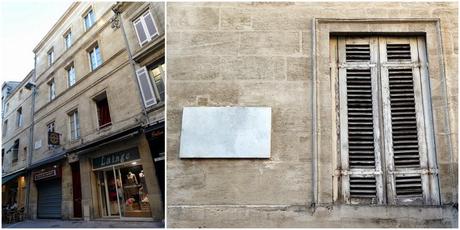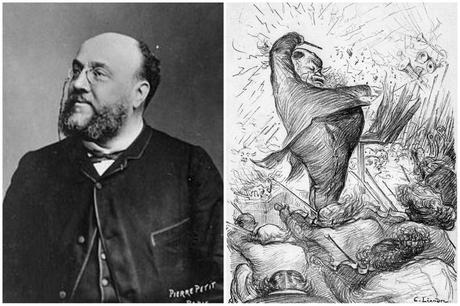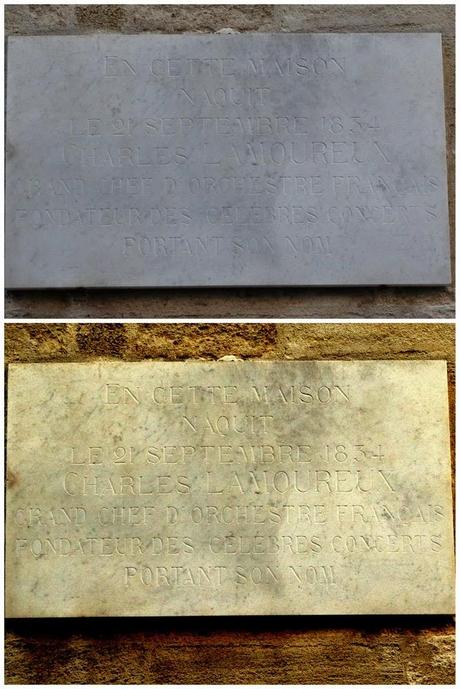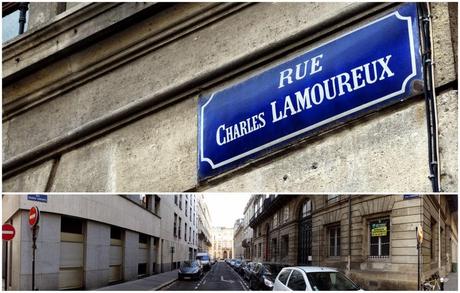 Towards the top end of Rue des Remparts, the charming, gently sloping pedestrianised street which connects Rue Porte Dijeaux and Place Pey-Berland, a discreet plaque can be seen on the wall of a three-storey building.
Towards the top end of Rue des Remparts, the charming, gently sloping pedestrianised street which connects Rue Porte Dijeaux and Place Pey-Berland, a discreet plaque can be seen on the wall of a three-storey building. The words are virtually illegible, given that they have been written in white on a white background. But that shouldn’t be enough to put us off deciphering the text: the plaque celebrates the birthplace of Charles Lamoureux, the illustrious violinist and conductor who did much to popularize the music of Berlioz, Wagner and Handel in France.
So this is indeed where Lamoureux was born on September 21st 1834. His father owned a café-restaurant, although it is unclear where his establishment was located. If simply on the ground floor it may have been where an “Atelier du Chocolat” store can now be seen, or else next door where Marcel Bistrot Français operates. Alternatively, it may have been a few hundred metres away on Rue Pont-Long (now Rue Georges-Bonnac), which is where Charles spent much of his childhood.

The birthplace of Charles Lamoureux, and the illegible white-on-white plaque.
Lamoureux showed early signs of being a prodigious violinist, so much so that at the age of 12 he joined the house orchestra of Bordeaux’s Grand Théâtre. Then, in 1859, aged just 15, he was dispatched to Paris to study the instrument under Narcisse Girard at the city’s Conservatoire, where he also studied theory and composition. The virtuoso’s promising start was sealed by a “premier prix” accolade in 1854 which paved the way to a position in the ranks of the orchestra at the Opéra de Paris. Then, in 1860, Lamoureux joined forces with fellow Bordelais Édouard Colonne to found a string quartet which put on a series of chamber music concerts, a move which formed the blueprint for his later success.
An official portrait of Charles Lamoureux, and a cartoon depicting his energetic style of conducting as produced by Charles Léandre for Le Rire magazine (source: Wikipedia).
In a way, Lamoureux’s biggest break came also in 1860 when he married the wealthy Marie-Pauline Mussot, whose finances provided him with the means to further innovate. Fresh from a trip to England where he had attended a Handel festival, Lamoureux elected to set up something similar back in Paris. This resulted in the foundation of the Société Française de l'Harmonie Sacrée.Come 1873, Lamoureux funded and conducted the first performance in Paris of Handel’s Messiah, as well as giving performances of Bach's St Matthew Passion, Handel's Judas Maccabaeus, Gounod's Gallia, and Massenet's Eve. Money eventually ran out though so Lamoureux took up paid posts at the Opéra-Comique then the Opéra. But both positions proved to be short-lived as the temperamental Lamoureux was notoriously difficult to work with and regularly fell out with his counterparts over musical productions.

The approximate location of Lamoureux's childhood residence on what is now Rue Georges-Bonnac.
Instead he turned to the Théâtre du Château d’Eau with whom he secured a contract to put on weekly symphonic concerts from 1881 onwards. For 16 years Lamoureux directed the initiative, originally known as Société des Nouveaux-Concerts, playing the music of contemporary composers such as Édouard Lalo, Camille Saint-Saëns, Emmanuel Chabrier and Paul Dukas, and becoming veritable ambassadors of the music of Hector Berlioz and Richard Wagner.Quality performance and high-standard musicianship were the name of the game. The highly-demanding Lamoureux recruited the best players available for his 125-strong orchestra (large by today’s standards), which comprised 78 strings, 20 wind and 18 brass. As well as the Parisian residence, the society toured Russia and performed in London. Then, in 1897, Lamoureux stepped aside and handed leadership duties over to his son-in-law Camille Chevillard. From that point onwards, the concerts and orchestra were given the name of their founder, as referred to on the Rue des Remparts plaque.

Through a bit of computer trickery, the text on the Rue des Remparts can just about be read.
Lamoureux subsequently rolled out grand plans to work abroad, but his final achievement was to play out back in Paris where he led his (former) orchestra for the first staged performances in France of Wagner’s Tristan und Isolde. After an exhausting series of 18 concerts, the conductor fell ill and just days later, on December 21st 1899, died of pulmonary edema. Lamoureux was buried at the Cimetière de Montmartre in the French capital.But Lamoureux’s legacy lives on: still today, 120 years down the line, the Orchestre Lamoureux continues to flourish and to be regarded as one of France’s most reputable ensembles. The outfit’s countless milestones include the premiere performances of Claude Debussy's Nocturnes (1900 and 1901) and La Mer (1905), and the first-ever recording of Bolero (1932), as conducted by composer Maurice Ravel himself. And many prestigious conductors have led the orchestra; these include Paul Paray, Igor Markevitch, Jean Martinon and Yutaka Sado.
 Back in Bordeaux, other than the white-on-white plaque on Rue des Remparts, Charles Lamoureux’s name has been given to a quiet street that runs perpendicular to Esplanade des Quinconces (pictured above). It all feels a long way from the energetic music composed by Wagner and Berlioz, and the atmosphere that must have reigned at those breakthrough 19th-century performances conducted by Lamoureux!
Back in Bordeaux, other than the white-on-white plaque on Rue des Remparts, Charles Lamoureux’s name has been given to a quiet street that runs perpendicular to Esplanade des Quinconces (pictured above). It all feels a long way from the energetic music composed by Wagner and Berlioz, and the atmosphere that must have reigned at those breakthrough 19th-century performances conducted by Lamoureux!- Find them on the Invisible Bordeaux map:
- Birthplace: 6 Rue des Remparts, Bordeaux
- Location of childhood home: 31 Rue Georges-Bonnac,
- Rue Charles Lamoureux, Bordeaux.
- And here is the modern-day Orchestre Lamoureux in action:
